Report on Managing Projects: Task 1 and Task 2 Analysis and Findings
VerifiedAdded on 2023/01/06
|18
|3844
|97
Report
AI Summary
This report presents a comprehensive analysis of project management principles, structured around two key tasks. Task 1 delves into the fundamental characteristics of projects, explores reasons for project failures, and outlines the project lifecycle stages including initiation, planning, execution, monitoring, and termination. It also examines the significance of team dynamics and knowledge areas like integration, scope, time, cost, quality, human resources, communication, risk, and procurement. The report further highlights attributes of a good manager and illustrates the calculation of a critical path using a network diagram, emphasizing its benefits. Task 2 focuses on the application of project management within HCL IT company, detailing the initiation phase with project objectives, time scales, and approaches. It defines the project scope, budgetary controls, and stakeholder analysis. The report includes a detailed task scheduling and management plan outlining the project timeline from initiation to deliverables.
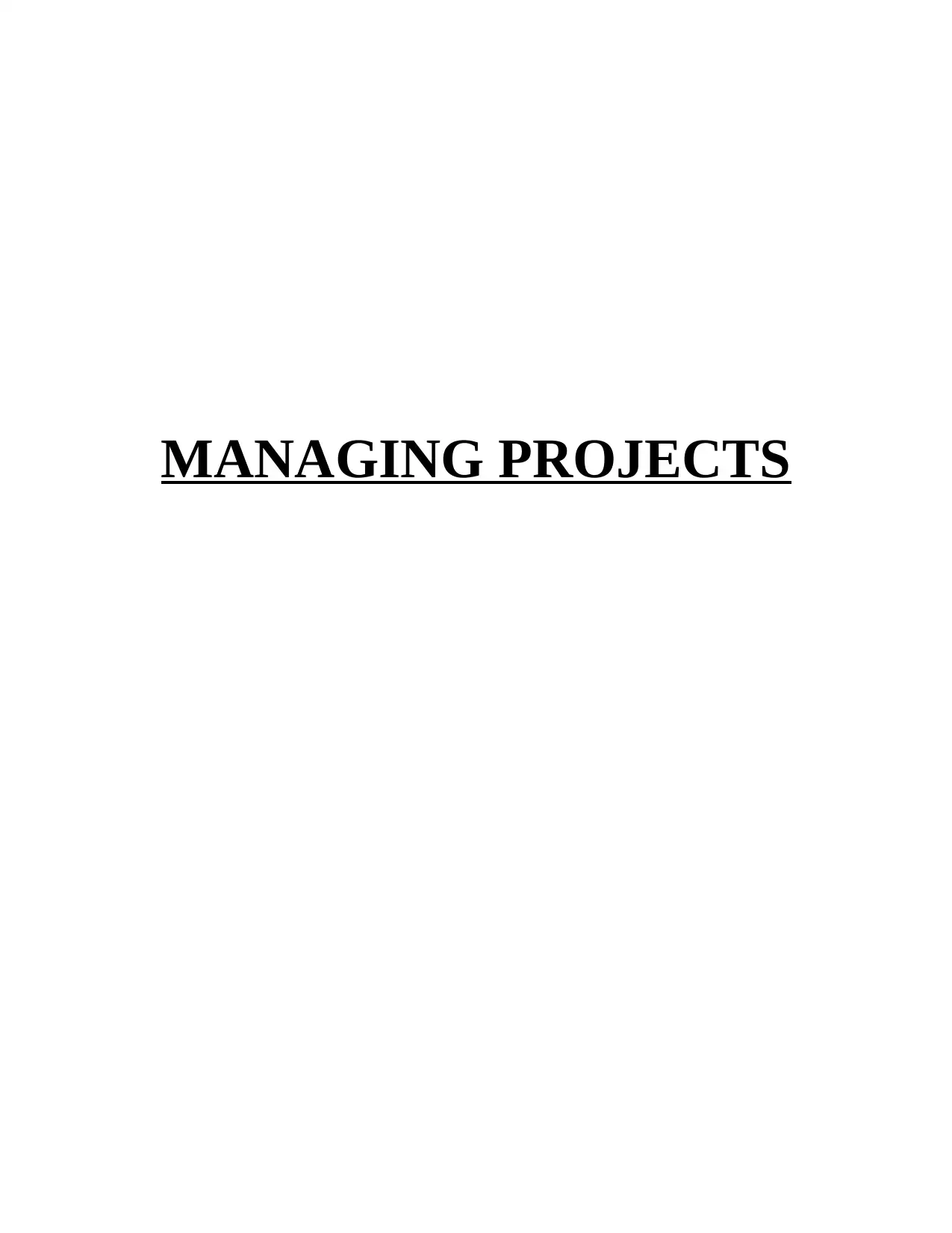
MANAGING PROJECTS
Paraphrase This Document
Need a fresh take? Get an instant paraphrase of this document with our AI Paraphraser
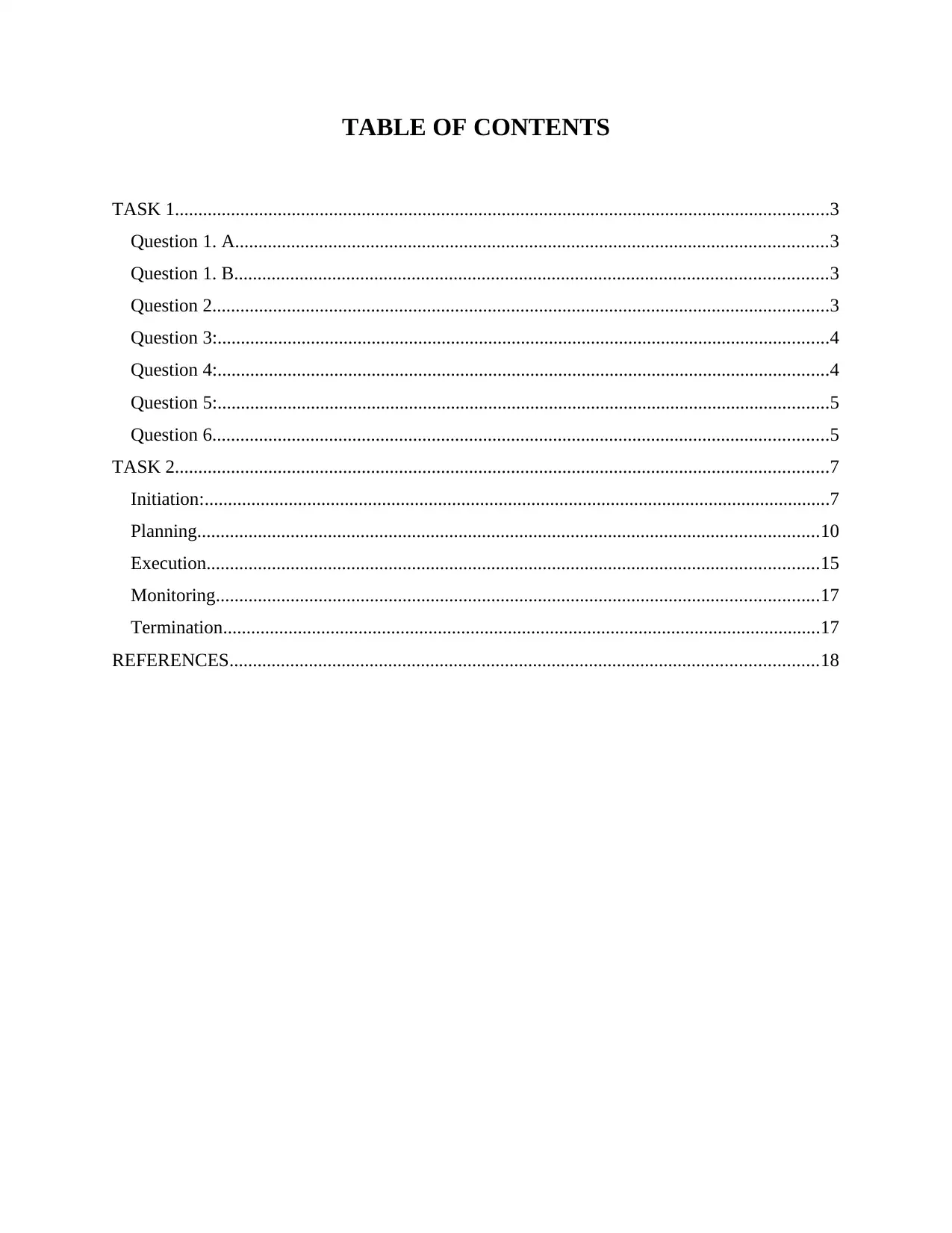
TABLE OF CONTENTS
TASK 1............................................................................................................................................3
Question 1. A...............................................................................................................................3
Question 1. B...............................................................................................................................3
Question 2....................................................................................................................................3
Question 3:...................................................................................................................................4
Question 4:...................................................................................................................................4
Question 5:...................................................................................................................................5
Question 6....................................................................................................................................5
TASK 2............................................................................................................................................7
Initiation:......................................................................................................................................7
Planning.....................................................................................................................................10
Execution...................................................................................................................................15
Monitoring.................................................................................................................................17
Termination................................................................................................................................17
REFERENCES..............................................................................................................................18
TASK 1............................................................................................................................................3
Question 1. A...............................................................................................................................3
Question 1. B...............................................................................................................................3
Question 2....................................................................................................................................3
Question 3:...................................................................................................................................4
Question 4:...................................................................................................................................4
Question 5:...................................................................................................................................5
Question 6....................................................................................................................................5
TASK 2............................................................................................................................................7
Initiation:......................................................................................................................................7
Planning.....................................................................................................................................10
Execution...................................................................................................................................15
Monitoring.................................................................................................................................17
Termination................................................................................................................................17
REFERENCES..............................................................................................................................18
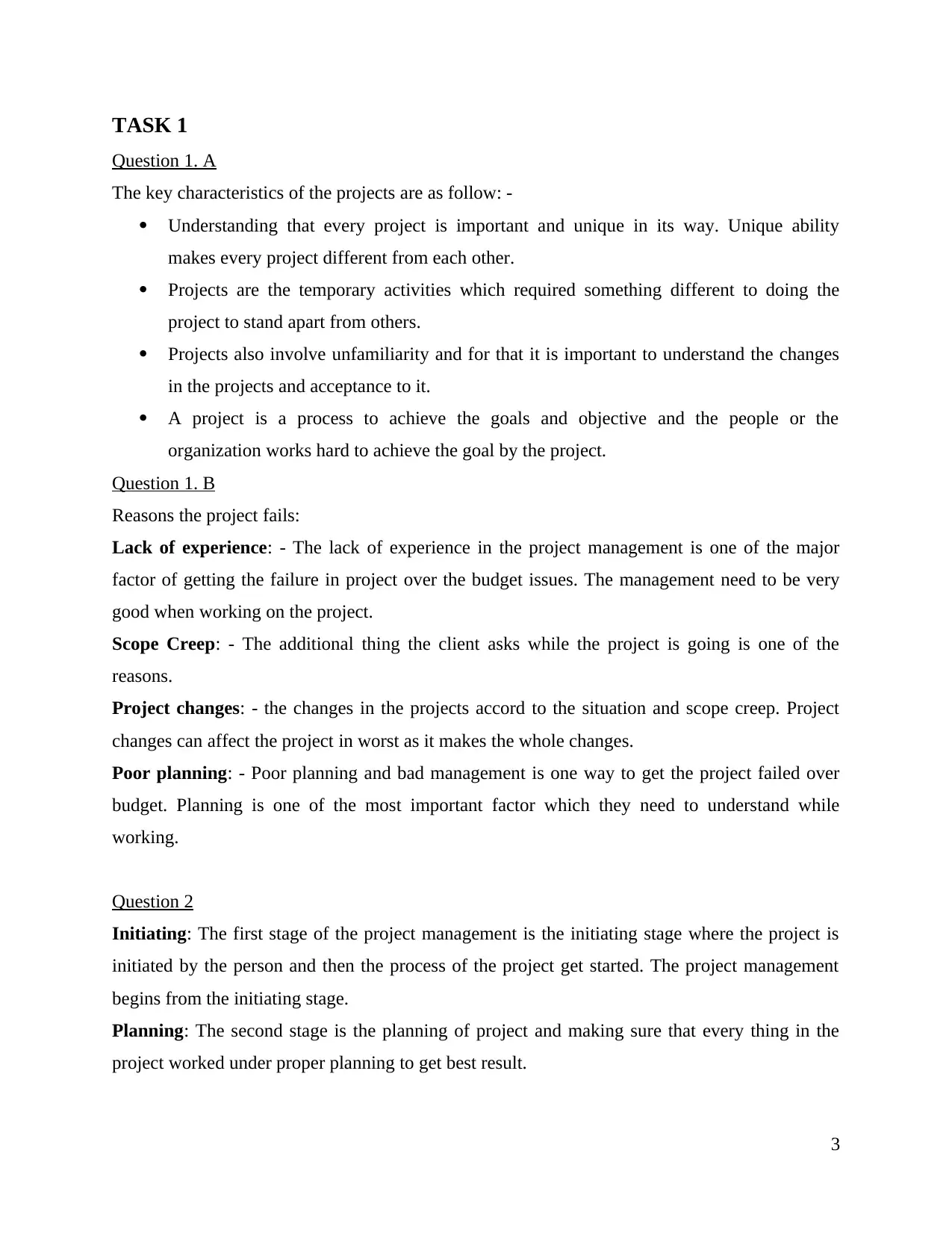
TASK 1
Question 1. A
The key characteristics of the projects are as follow: -
Understanding that every project is important and unique in its way. Unique ability
makes every project different from each other.
Projects are the temporary activities which required something different to doing the
project to stand apart from others.
Projects also involve unfamiliarity and for that it is important to understand the changes
in the projects and acceptance to it.
A project is a process to achieve the goals and objective and the people or the
organization works hard to achieve the goal by the project.
Question 1. B
Reasons the project fails:
Lack of experience: - The lack of experience in the project management is one of the major
factor of getting the failure in project over the budget issues. The management need to be very
good when working on the project.
Scope Creep: - The additional thing the client asks while the project is going is one of the
reasons.
Project changes: - the changes in the projects accord to the situation and scope creep. Project
changes can affect the project in worst as it makes the whole changes.
Poor planning: - Poor planning and bad management is one way to get the project failed over
budget. Planning is one of the most important factor which they need to understand while
working.
Question 2
Initiating: The first stage of the project management is the initiating stage where the project is
initiated by the person and then the process of the project get started. The project management
begins from the initiating stage.
Planning: The second stage is the planning of project and making sure that every thing in the
project worked under proper planning to get best result.
3
Question 1. A
The key characteristics of the projects are as follow: -
Understanding that every project is important and unique in its way. Unique ability
makes every project different from each other.
Projects are the temporary activities which required something different to doing the
project to stand apart from others.
Projects also involve unfamiliarity and for that it is important to understand the changes
in the projects and acceptance to it.
A project is a process to achieve the goals and objective and the people or the
organization works hard to achieve the goal by the project.
Question 1. B
Reasons the project fails:
Lack of experience: - The lack of experience in the project management is one of the major
factor of getting the failure in project over the budget issues. The management need to be very
good when working on the project.
Scope Creep: - The additional thing the client asks while the project is going is one of the
reasons.
Project changes: - the changes in the projects accord to the situation and scope creep. Project
changes can affect the project in worst as it makes the whole changes.
Poor planning: - Poor planning and bad management is one way to get the project failed over
budget. Planning is one of the most important factor which they need to understand while
working.
Question 2
Initiating: The first stage of the project management is the initiating stage where the project is
initiated by the person and then the process of the project get started. The project management
begins from the initiating stage.
Planning: The second stage is the planning of project and making sure that every thing in the
project worked under proper planning to get best result.
3
⊘ This is a preview!⊘
Do you want full access?
Subscribe today to unlock all pages.

Trusted by 1+ million students worldwide
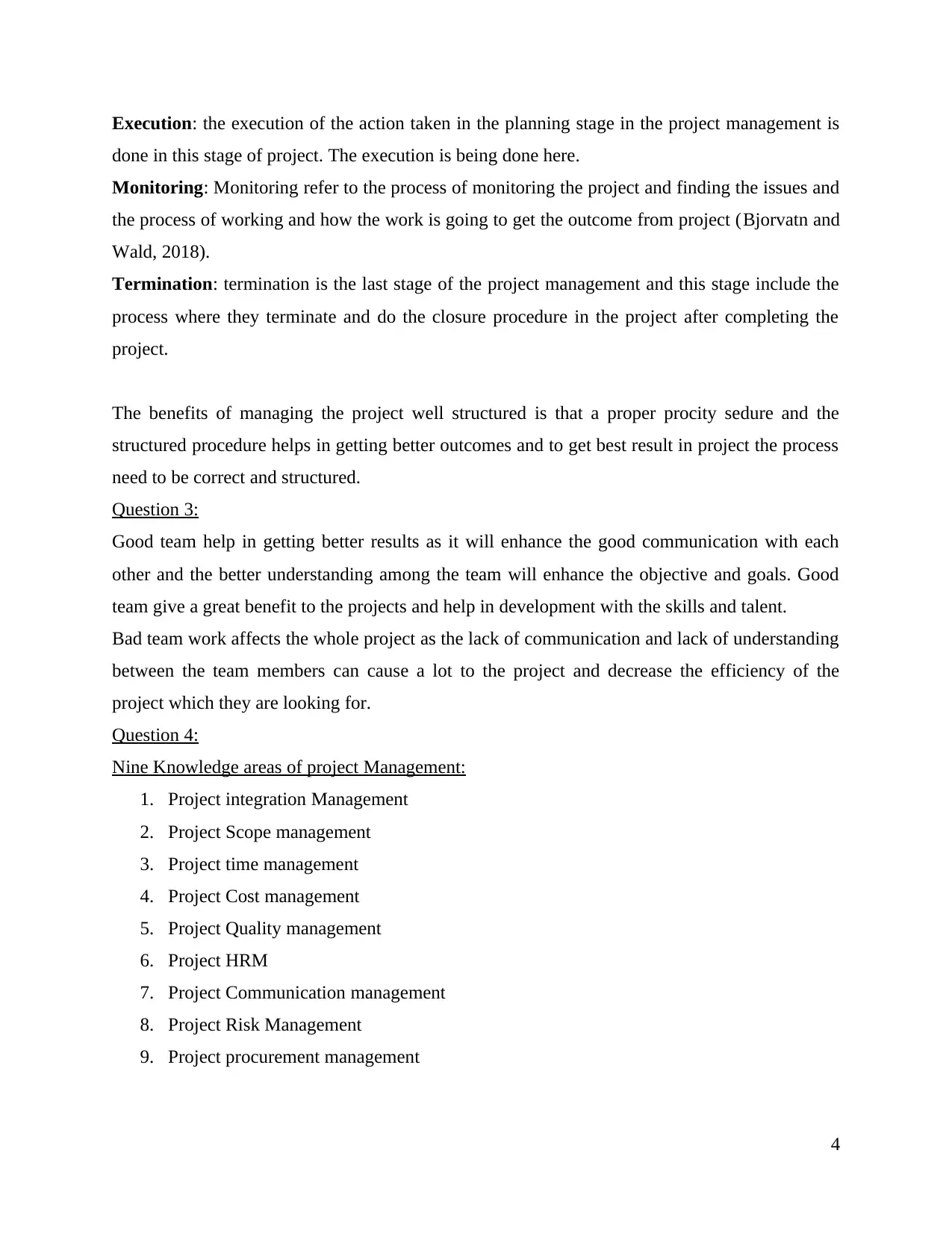
Execution: the execution of the action taken in the planning stage in the project management is
done in this stage of project. The execution is being done here.
Monitoring: Monitoring refer to the process of monitoring the project and finding the issues and
the process of working and how the work is going to get the outcome from project (Bjorvatn and
Wald, 2018).
Termination: termination is the last stage of the project management and this stage include the
process where they terminate and do the closure procedure in the project after completing the
project.
The benefits of managing the project well structured is that a proper procity sedure and the
structured procedure helps in getting better outcomes and to get best result in project the process
need to be correct and structured.
Question 3:
Good team help in getting better results as it will enhance the good communication with each
other and the better understanding among the team will enhance the objective and goals. Good
team give a great benefit to the projects and help in development with the skills and talent.
Bad team work affects the whole project as the lack of communication and lack of understanding
between the team members can cause a lot to the project and decrease the efficiency of the
project which they are looking for.
Question 4:
Nine Knowledge areas of project Management:
1. Project integration Management
2. Project Scope management
3. Project time management
4. Project Cost management
5. Project Quality management
6. Project HRM
7. Project Communication management
8. Project Risk Management
9. Project procurement management
4
done in this stage of project. The execution is being done here.
Monitoring: Monitoring refer to the process of monitoring the project and finding the issues and
the process of working and how the work is going to get the outcome from project (Bjorvatn and
Wald, 2018).
Termination: termination is the last stage of the project management and this stage include the
process where they terminate and do the closure procedure in the project after completing the
project.
The benefits of managing the project well structured is that a proper procity sedure and the
structured procedure helps in getting better outcomes and to get best result in project the process
need to be correct and structured.
Question 3:
Good team help in getting better results as it will enhance the good communication with each
other and the better understanding among the team will enhance the objective and goals. Good
team give a great benefit to the projects and help in development with the skills and talent.
Bad team work affects the whole project as the lack of communication and lack of understanding
between the team members can cause a lot to the project and decrease the efficiency of the
project which they are looking for.
Question 4:
Nine Knowledge areas of project Management:
1. Project integration Management
2. Project Scope management
3. Project time management
4. Project Cost management
5. Project Quality management
6. Project HRM
7. Project Communication management
8. Project Risk Management
9. Project procurement management
4
Paraphrase This Document
Need a fresh take? Get an instant paraphrase of this document with our AI Paraphraser
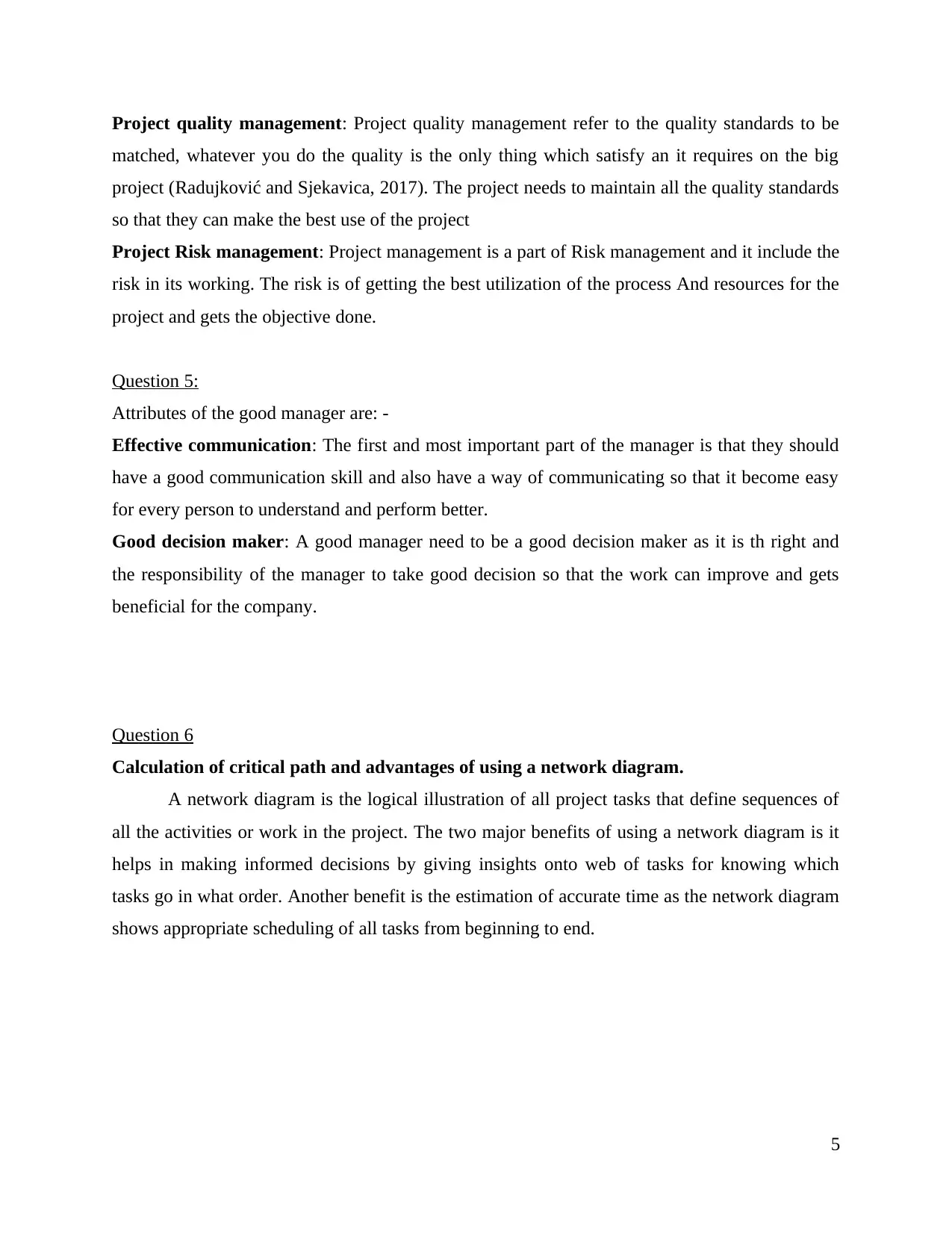
Project quality management: Project quality management refer to the quality standards to be
matched, whatever you do the quality is the only thing which satisfy an it requires on the big
project (Radujković and Sjekavica, 2017). The project needs to maintain all the quality standards
so that they can make the best use of the project
Project Risk management: Project management is a part of Risk management and it include the
risk in its working. The risk is of getting the best utilization of the process And resources for the
project and gets the objective done.
Question 5:
Attributes of the good manager are: -
Effective communication: The first and most important part of the manager is that they should
have a good communication skill and also have a way of communicating so that it become easy
for every person to understand and perform better.
Good decision maker: A good manager need to be a good decision maker as it is th right and
the responsibility of the manager to take good decision so that the work can improve and gets
beneficial for the company.
Question 6
Calculation of critical path and advantages of using a network diagram.
A network diagram is the logical illustration of all project tasks that define sequences of
all the activities or work in the project. The two major benefits of using a network diagram is it
helps in making informed decisions by giving insights onto web of tasks for knowing which
tasks go in what order. Another benefit is the estimation of accurate time as the network diagram
shows appropriate scheduling of all tasks from beginning to end.
5
matched, whatever you do the quality is the only thing which satisfy an it requires on the big
project (Radujković and Sjekavica, 2017). The project needs to maintain all the quality standards
so that they can make the best use of the project
Project Risk management: Project management is a part of Risk management and it include the
risk in its working. The risk is of getting the best utilization of the process And resources for the
project and gets the objective done.
Question 5:
Attributes of the good manager are: -
Effective communication: The first and most important part of the manager is that they should
have a good communication skill and also have a way of communicating so that it become easy
for every person to understand and perform better.
Good decision maker: A good manager need to be a good decision maker as it is th right and
the responsibility of the manager to take good decision so that the work can improve and gets
beneficial for the company.
Question 6
Calculation of critical path and advantages of using a network diagram.
A network diagram is the logical illustration of all project tasks that define sequences of
all the activities or work in the project. The two major benefits of using a network diagram is it
helps in making informed decisions by giving insights onto web of tasks for knowing which
tasks go in what order. Another benefit is the estimation of accurate time as the network diagram
shows appropriate scheduling of all tasks from beginning to end.
5
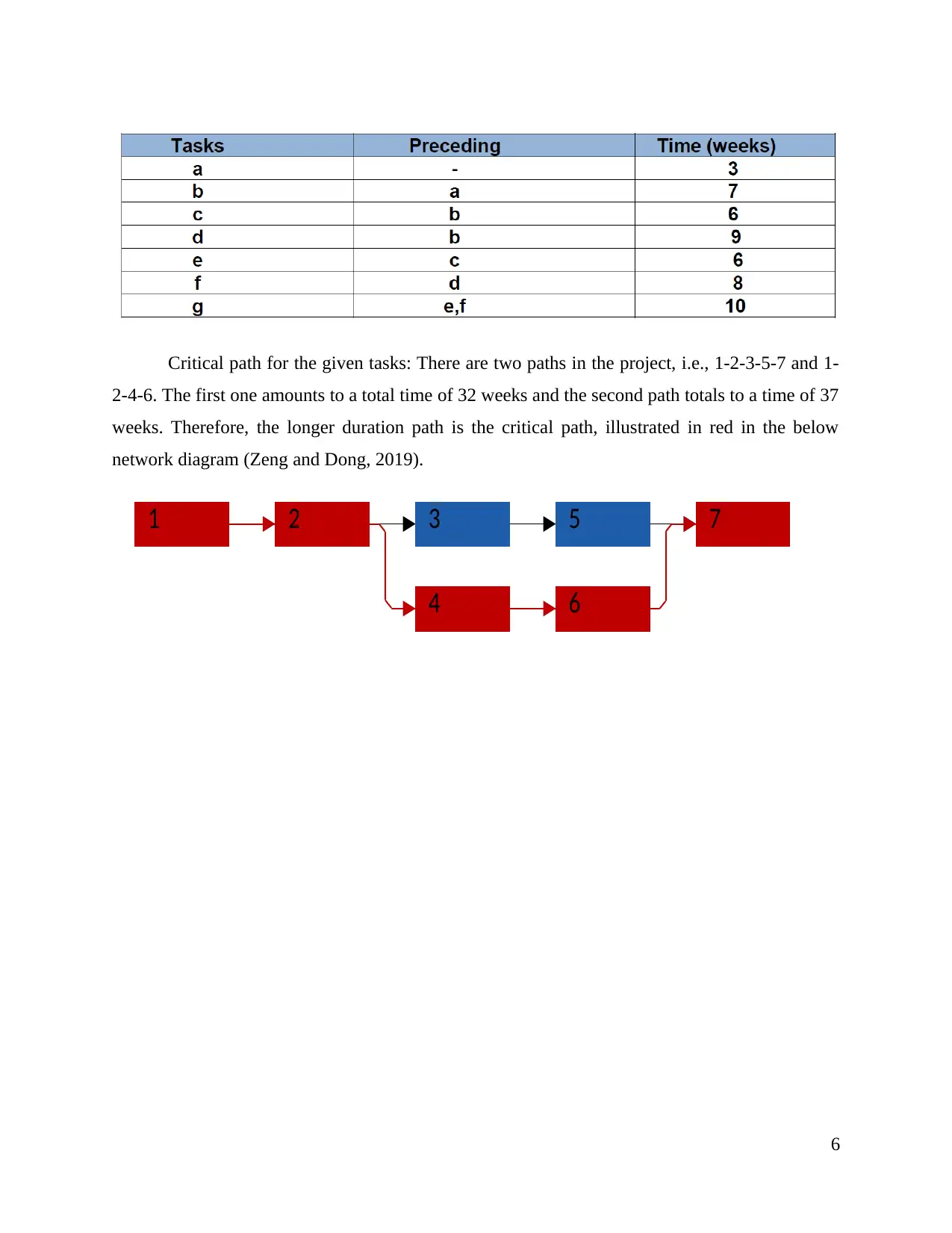
Critical path for the given tasks: There are two paths in the project, i.e., 1-2-3-5-7 and 1-
2-4-6. The first one amounts to a total time of 32 weeks and the second path totals to a time of 37
weeks. Therefore, the longer duration path is the critical path, illustrated in red in the below
network diagram (Zeng and Dong, 2019).
2 3
4
5
6
71
6
2-4-6. The first one amounts to a total time of 32 weeks and the second path totals to a time of 37
weeks. Therefore, the longer duration path is the critical path, illustrated in red in the below
network diagram (Zeng and Dong, 2019).
2 3
4
5
6
71
6
⊘ This is a preview!⊘
Do you want full access?
Subscribe today to unlock all pages.

Trusted by 1+ million students worldwide
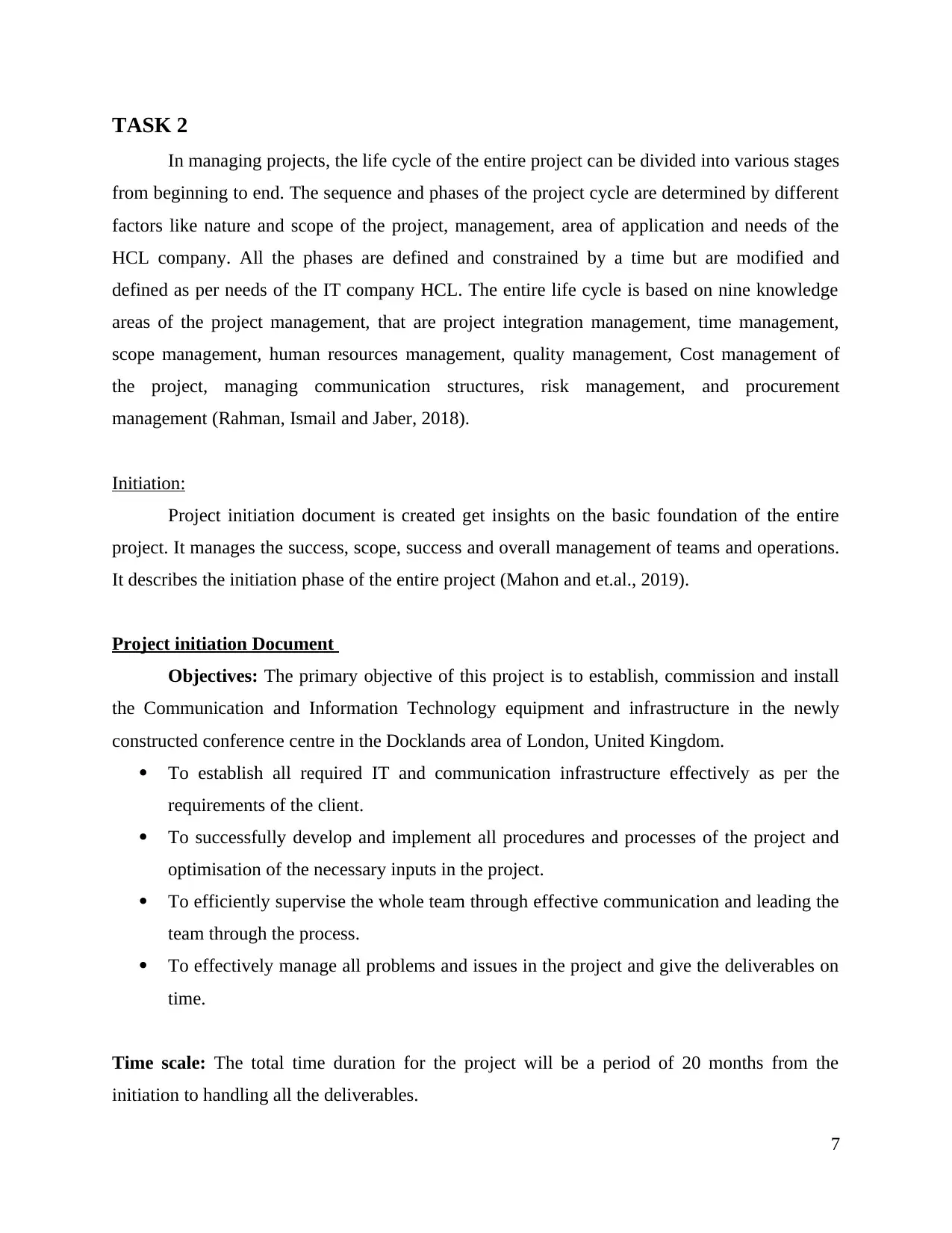
TASK 2
In managing projects, the life cycle of the entire project can be divided into various stages
from beginning to end. The sequence and phases of the project cycle are determined by different
factors like nature and scope of the project, management, area of application and needs of the
HCL company. All the phases are defined and constrained by a time but are modified and
defined as per needs of the IT company HCL. The entire life cycle is based on nine knowledge
areas of the project management, that are project integration management, time management,
scope management, human resources management, quality management, Cost management of
the project, managing communication structures, risk management, and procurement
management (Rahman, Ismail and Jaber, 2018).
Initiation:
Project initiation document is created get insights on the basic foundation of the entire
project. It manages the success, scope, success and overall management of teams and operations.
It describes the initiation phase of the entire project (Mahon and et.al., 2019).
Project initiation Document
Objectives: The primary objective of this project is to establish, commission and install
the Communication and Information Technology equipment and infrastructure in the newly
constructed conference centre in the Docklands area of London, United Kingdom.
To establish all required IT and communication infrastructure effectively as per the
requirements of the client.
To successfully develop and implement all procedures and processes of the project and
optimisation of the necessary inputs in the project.
To efficiently supervise the whole team through effective communication and leading the
team through the process.
To effectively manage all problems and issues in the project and give the deliverables on
time.
Time scale: The total time duration for the project will be a period of 20 months from the
initiation to handling all the deliverables.
7
In managing projects, the life cycle of the entire project can be divided into various stages
from beginning to end. The sequence and phases of the project cycle are determined by different
factors like nature and scope of the project, management, area of application and needs of the
HCL company. All the phases are defined and constrained by a time but are modified and
defined as per needs of the IT company HCL. The entire life cycle is based on nine knowledge
areas of the project management, that are project integration management, time management,
scope management, human resources management, quality management, Cost management of
the project, managing communication structures, risk management, and procurement
management (Rahman, Ismail and Jaber, 2018).
Initiation:
Project initiation document is created get insights on the basic foundation of the entire
project. It manages the success, scope, success and overall management of teams and operations.
It describes the initiation phase of the entire project (Mahon and et.al., 2019).
Project initiation Document
Objectives: The primary objective of this project is to establish, commission and install
the Communication and Information Technology equipment and infrastructure in the newly
constructed conference centre in the Docklands area of London, United Kingdom.
To establish all required IT and communication infrastructure effectively as per the
requirements of the client.
To successfully develop and implement all procedures and processes of the project and
optimisation of the necessary inputs in the project.
To efficiently supervise the whole team through effective communication and leading the
team through the process.
To effectively manage all problems and issues in the project and give the deliverables on
time.
Time scale: The total time duration for the project will be a period of 20 months from the
initiation to handling all the deliverables.
7
Paraphrase This Document
Need a fresh take? Get an instant paraphrase of this document with our AI Paraphraser
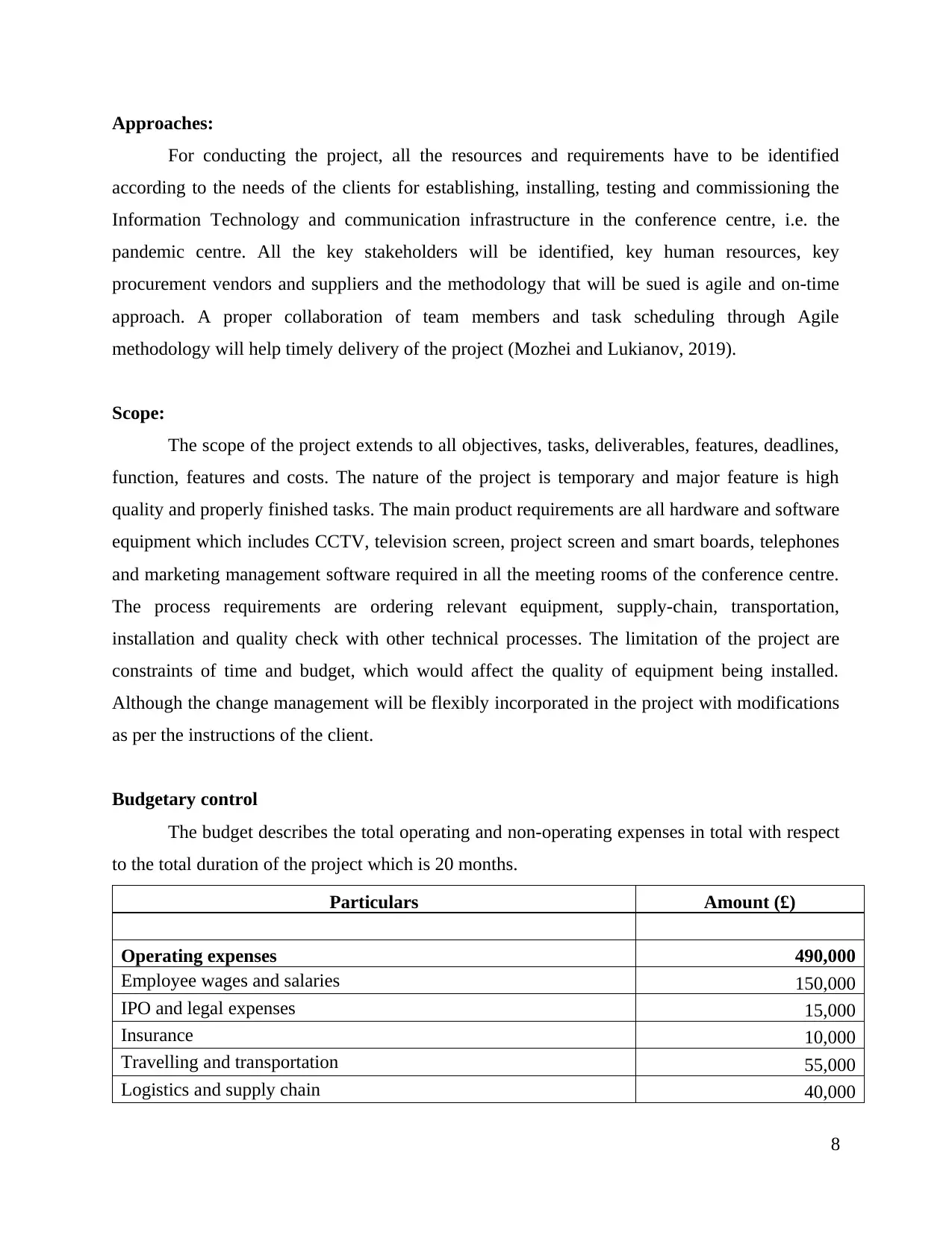
Approaches:
For conducting the project, all the resources and requirements have to be identified
according to the needs of the clients for establishing, installing, testing and commissioning the
Information Technology and communication infrastructure in the conference centre, i.e. the
pandemic centre. All the key stakeholders will be identified, key human resources, key
procurement vendors and suppliers and the methodology that will be sued is agile and on-time
approach. A proper collaboration of team members and task scheduling through Agile
methodology will help timely delivery of the project (Mozhei and Lukianov, 2019).
Scope:
The scope of the project extends to all objectives, tasks, deliverables, features, deadlines,
function, features and costs. The nature of the project is temporary and major feature is high
quality and properly finished tasks. The main product requirements are all hardware and software
equipment which includes CCTV, television screen, project screen and smart boards, telephones
and marketing management software required in all the meeting rooms of the conference centre.
The process requirements are ordering relevant equipment, supply-chain, transportation,
installation and quality check with other technical processes. The limitation of the project are
constraints of time and budget, which would affect the quality of equipment being installed.
Although the change management will be flexibly incorporated in the project with modifications
as per the instructions of the client.
Budgetary control
The budget describes the total operating and non-operating expenses in total with respect
to the total duration of the project which is 20 months.
Particulars Amount (£)
Operating expenses 490,000
Employee wages and salaries 150,000
IPO and legal expenses 15,000
Insurance 10,000
Travelling and transportation 55,000
Logistics and supply chain 40,000
8
For conducting the project, all the resources and requirements have to be identified
according to the needs of the clients for establishing, installing, testing and commissioning the
Information Technology and communication infrastructure in the conference centre, i.e. the
pandemic centre. All the key stakeholders will be identified, key human resources, key
procurement vendors and suppliers and the methodology that will be sued is agile and on-time
approach. A proper collaboration of team members and task scheduling through Agile
methodology will help timely delivery of the project (Mozhei and Lukianov, 2019).
Scope:
The scope of the project extends to all objectives, tasks, deliverables, features, deadlines,
function, features and costs. The nature of the project is temporary and major feature is high
quality and properly finished tasks. The main product requirements are all hardware and software
equipment which includes CCTV, television screen, project screen and smart boards, telephones
and marketing management software required in all the meeting rooms of the conference centre.
The process requirements are ordering relevant equipment, supply-chain, transportation,
installation and quality check with other technical processes. The limitation of the project are
constraints of time and budget, which would affect the quality of equipment being installed.
Although the change management will be flexibly incorporated in the project with modifications
as per the instructions of the client.
Budgetary control
The budget describes the total operating and non-operating expenses in total with respect
to the total duration of the project which is 20 months.
Particulars Amount (£)
Operating expenses 490,000
Employee wages and salaries 150,000
IPO and legal expenses 15,000
Insurance 10,000
Travelling and transportation 55,000
Logistics and supply chain 40,000
8
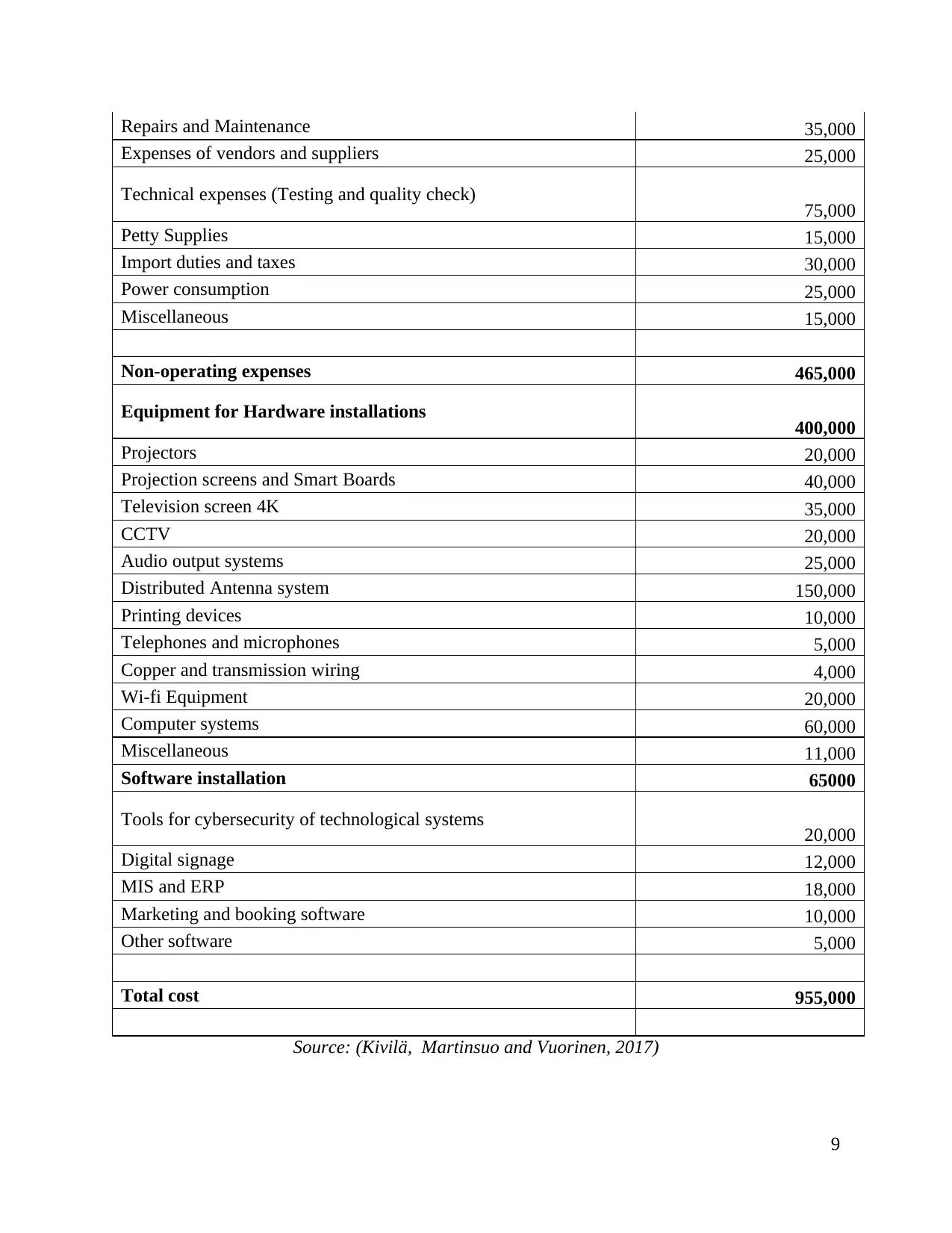
Repairs and Maintenance 35,000
Expenses of vendors and suppliers 25,000
Technical expenses (Testing and quality check) 75,000
Petty Supplies 15,000
Import duties and taxes 30,000
Power consumption 25,000
Miscellaneous 15,000
Non-operating expenses 465,000
Equipment for Hardware installations 400,000
Projectors 20,000
Projection screens and Smart Boards 40,000
Television screen 4K 35,000
CCTV 20,000
Audio output systems 25,000
Distributed Antenna system 150,000
Printing devices 10,000
Telephones and microphones 5,000
Copper and transmission wiring 4,000
Wi-fi Equipment 20,000
Computer systems 60,000
Miscellaneous 11,000
Software installation 65000
Tools for cybersecurity of technological systems 20,000
Digital signage 12,000
MIS and ERP 18,000
Marketing and booking software 10,000
Other software 5,000
Total cost 955,000
Source: (Kivilä, Martinsuo and Vuorinen, 2017)
9
Expenses of vendors and suppliers 25,000
Technical expenses (Testing and quality check) 75,000
Petty Supplies 15,000
Import duties and taxes 30,000
Power consumption 25,000
Miscellaneous 15,000
Non-operating expenses 465,000
Equipment for Hardware installations 400,000
Projectors 20,000
Projection screens and Smart Boards 40,000
Television screen 4K 35,000
CCTV 20,000
Audio output systems 25,000
Distributed Antenna system 150,000
Printing devices 10,000
Telephones and microphones 5,000
Copper and transmission wiring 4,000
Wi-fi Equipment 20,000
Computer systems 60,000
Miscellaneous 11,000
Software installation 65000
Tools for cybersecurity of technological systems 20,000
Digital signage 12,000
MIS and ERP 18,000
Marketing and booking software 10,000
Other software 5,000
Total cost 955,000
Source: (Kivilä, Martinsuo and Vuorinen, 2017)
9
⊘ This is a preview!⊘
Do you want full access?
Subscribe today to unlock all pages.

Trusted by 1+ million students worldwide
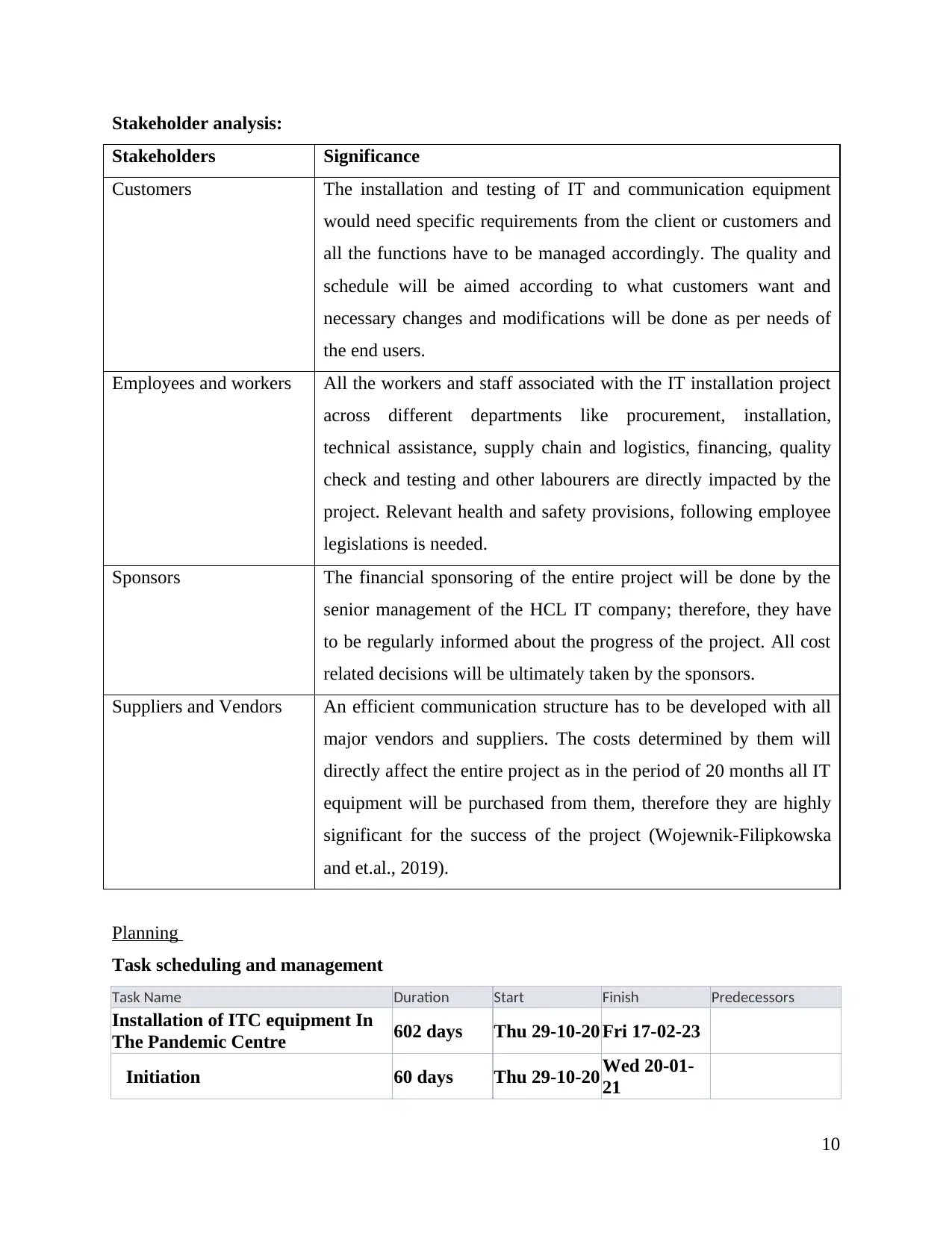
Stakeholder analysis:
Stakeholders Significance
Customers The installation and testing of IT and communication equipment
would need specific requirements from the client or customers and
all the functions have to be managed accordingly. The quality and
schedule will be aimed according to what customers want and
necessary changes and modifications will be done as per needs of
the end users.
Employees and workers All the workers and staff associated with the IT installation project
across different departments like procurement, installation,
technical assistance, supply chain and logistics, financing, quality
check and testing and other labourers are directly impacted by the
project. Relevant health and safety provisions, following employee
legislations is needed.
Sponsors The financial sponsoring of the entire project will be done by the
senior management of the HCL IT company; therefore, they have
to be regularly informed about the progress of the project. All cost
related decisions will be ultimately taken by the sponsors.
Suppliers and Vendors An efficient communication structure has to be developed with all
major vendors and suppliers. The costs determined by them will
directly affect the entire project as in the period of 20 months all IT
equipment will be purchased from them, therefore they are highly
significant for the success of the project (Wojewnik-Filipkowska
and et.al., 2019).
Planning
Task scheduling and management
Task Name Duration Start Finish Predecessors
Installation of ITC equipment In
The Pandemic Centre 602 days Thu 29-10-20 Fri 17-02-23
Initiation 60 days Thu 29-10-20 Wed 20-01-
21
10
Stakeholders Significance
Customers The installation and testing of IT and communication equipment
would need specific requirements from the client or customers and
all the functions have to be managed accordingly. The quality and
schedule will be aimed according to what customers want and
necessary changes and modifications will be done as per needs of
the end users.
Employees and workers All the workers and staff associated with the IT installation project
across different departments like procurement, installation,
technical assistance, supply chain and logistics, financing, quality
check and testing and other labourers are directly impacted by the
project. Relevant health and safety provisions, following employee
legislations is needed.
Sponsors The financial sponsoring of the entire project will be done by the
senior management of the HCL IT company; therefore, they have
to be regularly informed about the progress of the project. All cost
related decisions will be ultimately taken by the sponsors.
Suppliers and Vendors An efficient communication structure has to be developed with all
major vendors and suppliers. The costs determined by them will
directly affect the entire project as in the period of 20 months all IT
equipment will be purchased from them, therefore they are highly
significant for the success of the project (Wojewnik-Filipkowska
and et.al., 2019).
Planning
Task scheduling and management
Task Name Duration Start Finish Predecessors
Installation of ITC equipment In
The Pandemic Centre 602 days Thu 29-10-20 Fri 17-02-23
Initiation 60 days Thu 29-10-20 Wed 20-01-
21
10
Paraphrase This Document
Need a fresh take? Get an instant paraphrase of this document with our AI Paraphraser
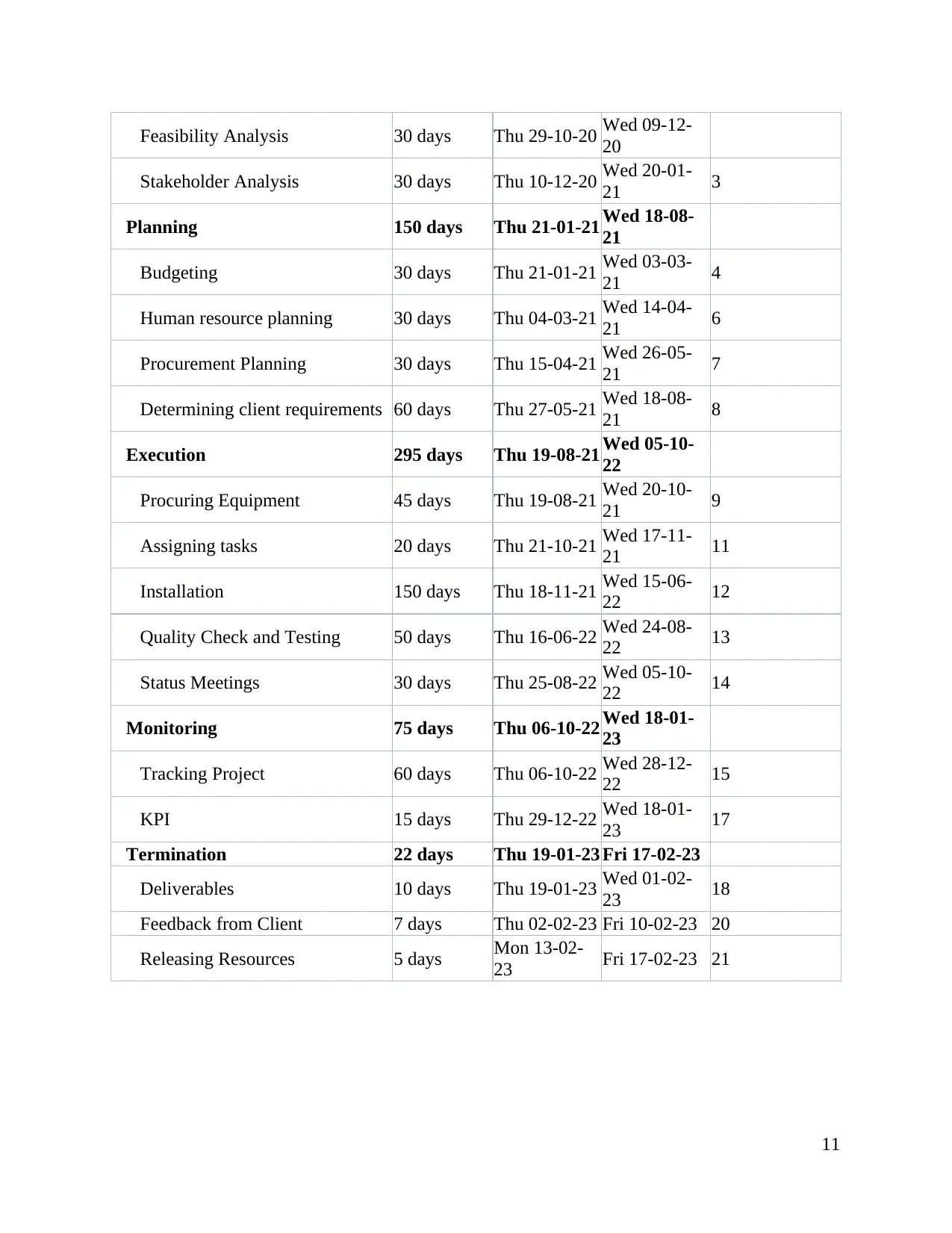
Feasibility Analysis 30 days Thu 29-10-20 Wed 09-12-
20
Stakeholder Analysis 30 days Thu 10-12-20 Wed 20-01-
21 3
Planning 150 days Thu 21-01-21 Wed 18-08-
21
Budgeting 30 days Thu 21-01-21 Wed 03-03-
21 4
Human resource planning 30 days Thu 04-03-21 Wed 14-04-
21 6
Procurement Planning 30 days Thu 15-04-21 Wed 26-05-
21 7
Determining client requirements 60 days Thu 27-05-21 Wed 18-08-
21 8
Execution 295 days Thu 19-08-21 Wed 05-10-
22
Procuring Equipment 45 days Thu 19-08-21 Wed 20-10-
21 9
Assigning tasks 20 days Thu 21-10-21 Wed 17-11-
21 11
Installation 150 days Thu 18-11-21 Wed 15-06-
22 12
Quality Check and Testing 50 days Thu 16-06-22 Wed 24-08-
22 13
Status Meetings 30 days Thu 25-08-22 Wed 05-10-
22 14
Monitoring 75 days Thu 06-10-22 Wed 18-01-
23
Tracking Project 60 days Thu 06-10-22 Wed 28-12-
22 15
KPI 15 days Thu 29-12-22 Wed 18-01-
23 17
Termination 22 days Thu 19-01-23 Fri 17-02-23
Deliverables 10 days Thu 19-01-23 Wed 01-02-
23 18
Feedback from Client 7 days Thu 02-02-23 Fri 10-02-23 20
Releasing Resources 5 days Mon 13-02-
23 Fri 17-02-23 21
11
20
Stakeholder Analysis 30 days Thu 10-12-20 Wed 20-01-
21 3
Planning 150 days Thu 21-01-21 Wed 18-08-
21
Budgeting 30 days Thu 21-01-21 Wed 03-03-
21 4
Human resource planning 30 days Thu 04-03-21 Wed 14-04-
21 6
Procurement Planning 30 days Thu 15-04-21 Wed 26-05-
21 7
Determining client requirements 60 days Thu 27-05-21 Wed 18-08-
21 8
Execution 295 days Thu 19-08-21 Wed 05-10-
22
Procuring Equipment 45 days Thu 19-08-21 Wed 20-10-
21 9
Assigning tasks 20 days Thu 21-10-21 Wed 17-11-
21 11
Installation 150 days Thu 18-11-21 Wed 15-06-
22 12
Quality Check and Testing 50 days Thu 16-06-22 Wed 24-08-
22 13
Status Meetings 30 days Thu 25-08-22 Wed 05-10-
22 14
Monitoring 75 days Thu 06-10-22 Wed 18-01-
23
Tracking Project 60 days Thu 06-10-22 Wed 28-12-
22 15
KPI 15 days Thu 29-12-22 Wed 18-01-
23 17
Termination 22 days Thu 19-01-23 Fri 17-02-23
Deliverables 10 days Thu 19-01-23 Wed 01-02-
23 18
Feedback from Client 7 days Thu 02-02-23 Fri 10-02-23 20
Releasing Resources 5 days Mon 13-02-
23 Fri 17-02-23 21
11
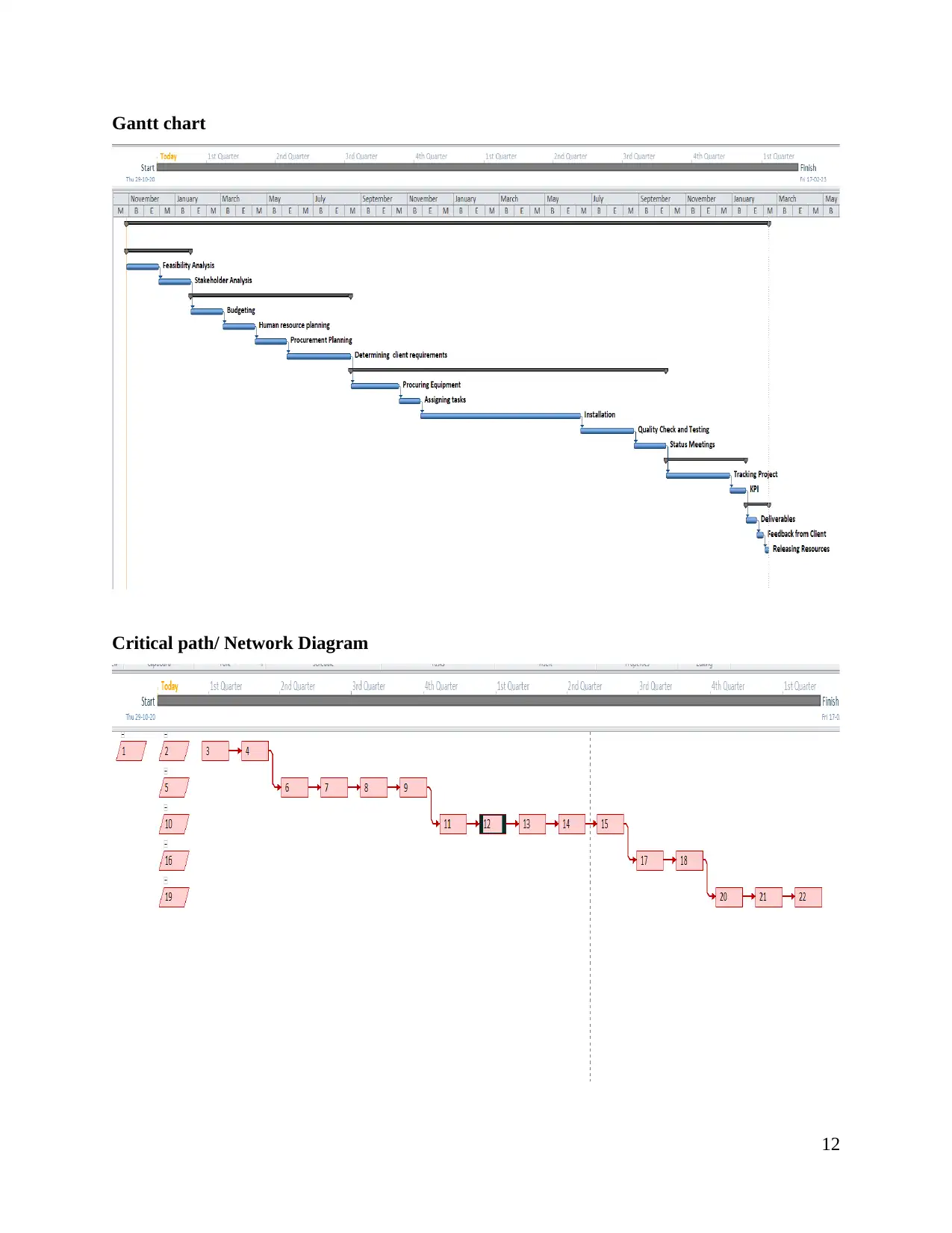
Gantt chart
Critical path/ Network Diagram
12
Critical path/ Network Diagram
12
⊘ This is a preview!⊘
Do you want full access?
Subscribe today to unlock all pages.

Trusted by 1+ million students worldwide
1 out of 18
Related Documents
Your All-in-One AI-Powered Toolkit for Academic Success.
+13062052269
info@desklib.com
Available 24*7 on WhatsApp / Email
![[object Object]](/_next/static/media/star-bottom.7253800d.svg)
Unlock your academic potential
Copyright © 2020–2025 A2Z Services. All Rights Reserved. Developed and managed by ZUCOL.





